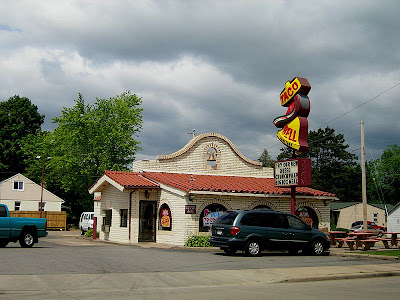 ^
^
^
^
THE GUILTY PARTY ^
TO BEGIN.
"My fellow chiefs and I would like the white man to know that the red man has great heroes, too."
~Chief Henry Standing Bear in the year 1939, to the architects responsible for the construction of the Mt. Rushmore.
It is a challenge to think of an American Monument with more sorted connotations than this:

Mount Rushmore National Memorial
- Near Keystone, South Dakota
- Monumental granite structure by Gutzon Borglum
- (left to right): George Washington (1732–1799), Thomas Jefferson (1743–1826), Theodore Roosevelt (1858–1919), and Abraham Lincoln (1809–1865)
- The entire memorial covers 1,278.45 acres
- The memorial attracts approximately two million people per year
- Construction of the monument started in 1927 and ended in 1941
It's like, sure, there ARE probably some to someone that are more controversial. Show this image to a fifth grader and they'd probably tell you it is "a monument to great leaders from history." No contraversy there. Was named by a lawyer from New York, for god's sake.
Alas.
To a great many people, this monument is more than just a monument to great American leaders.
It is a symbol of the oppression of the native people of the land. It is a symbol that causes much sadness to some who once called the mountain the "Six Grandfathers." It is a symbol of the conduct of the American Government towards the American Indian- a government that breaks it's promises unflinchingly and repeatedly.
The land was taken from the Lakota tribe after the Great Sioux War of 1876-77.
The Treaty of Fort Laramie from 1868 had previously granted the Black Hills to the Lakota permanently.
Whell Naow, yousee here? That juss don't sit right with us art students. And when somethin' Don' sit right, whell, that's why we have photoshop, now, aint it?
And then a man dressed as a BEE whips out a sharpie:
What we need now? Some REAL american heroes. And because this land belongs to the Lakota, well, goddamn it if each of those heroes ought to be Real Lakota Heroes:
 Red Cloud (1822 - 1909)
Red Cloud (1822 - 1909)
Red Cloud was a war leader of the Oglala Lakota, and one of the most capable Native American opponents the United States Army ever faced.
Red Cloud's warriors made a statement by slaughtering the entire detachment of 81 cavalry and infantrymen and only suffering 14 casualties th
emselves. Following this battle, a peace commission toured the plains in 1867 and was able to determine that most of the Indian violence had in fact been provoked by the whites. This discovery led to the ending of the war in 1868, in a victory by the Lakota as the US signed the Treaty of Fort Laramie and agreed to withdraw completely from Lakota territory.
Red Cloud became an important leader of the Lakota as they transitioned from the freedom of the plains to the confinement of the reservation system. He outlived the other major Sioux leaders of the Indian wars and died in 1909 at the age of 87.
Crazy Horse (1840 – September 5, 1877)
Crazy Horse was a respected war leader of the Oglala Lakota, who
fought against the U.S. federal government in an effort to preserve the traditions and values of the Lakota way of life. He is most generally known for his participation in the Battle of little Bighorn in Jun
e, 1876.
Sitting Bull was a Hunkpapa Soix holy man, killed by reservation police on the Standing Rock Res. during an attempt to arrest him and prevent him from supporting the Ghost Dance movement. He is noted for his role in the major victory at the Battle of the Little Bighorn.
Black Elk (1863 -1950)
Black Elk served as a Wichasha Wakan, or spiritual leader
among his people in the later years of his life.
One of the first of he Lakota tribe to document stories of
his tribe, as both an interpreter and a self published novelist.
Was the second cousin of Crazy Horse.
4 TOTALLY Bossy Soiux Leaders, all of them recognised and loved by thier people, especially the Oglala Lakota.
AND
...
All of them depicted in this REDUX, Which is the next best thing to just dynamiting the mountainside away as a bad memory.
Naturally, the google EARTH thingy is still pending.
As a delightful side note,
- Crazy horse monument is currently being constructed in the Black Hills to honor the famous Native American leader; Crazy Horse, as a response to Mount Rushmore.
- Supposed to be larger than Mount Rushmore and has the support of the Lakota Chiefs.
- The monument has rejected offers of federal funds.
Please Visit the website at http://www.crazyhorsememorial.org/










